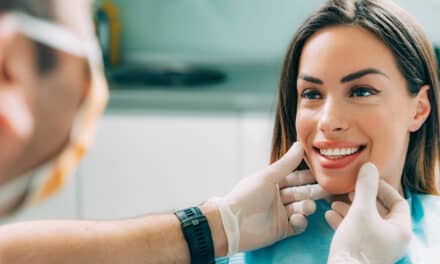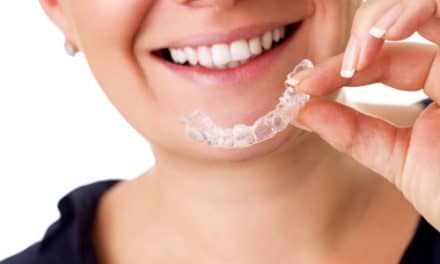Adult and teen patients share similar treatment goals. But the adult relapse patient is often more insistent on quick treatment and a retention plan that maintains results.
By Michael J. Mayhew, DDS, MS, MS
While adults seeking orthodontic care often share similar treatment goals as teenagers, adults may present with challenges not often seen with a younger patient group. Challenges of periodontal health, dental restorations or missing teeth, and jaw function may be present and need to be addressed by the practitioner. However, often the chief challenge to the orthodontist is the adult patient’s desire to have treatment completed quickly, not hinder their day-to-day world, be as transparent as possible, and the result be stable.
A particular grouping of adult patients seeking care are those who had orthodontic care as teenagers and for various reasons have experienced relapse. The long-term effect of orthodontic treatment has attracted increasing interest during the last several decades. Reviews of relapsed care show that 40% to 90% of the orthodontically treated patients have dental alignment results as unacceptable just 10 years after retention began.1
Orthodontists may see large individual variations of alignment changes in adults. Most studies indicate that it is difficult to stress any single causative factor and that it is instead a multifactorial problem.2 As treatment plans are developed, understanding the natural aging process that may have contributed, along with any dental relapse from prior treatment, should all be considered in any retreatment plan. While most of these causative factors may relate to normal developmental processes, how the case was managed previously, and type and duration of retention, can be key elements. Of equal importance is what retention procedures are planned for an improved extended period of stability.
Case Report
This 42-year-old female patient had orthodontic treatment with fixed braces and with upper and lower first premolar extractions as a teenager. While she had seen changes in how her teeth were aligned, she believed it had become worse more recently. In addition, she had been experiencing some jaw joint discomfort characterized as “tightness” and with “noise on opening and closing.” Her health history was unremarkable.
After obtaining diagnostic records (Figures 1), the following problem list was reviewed:
- Chief complaint: “tooth alignment getting worse” and “jaw soreness”
- Dental malalignment and crowding both arches
- Narrow arch widths contributing to crowding
- Mild Class III skeletal pattern
- Deep bite with a significant lower incisor wear pattern
- Dental composite restoration in poor repair mandibular left first molar
- Left side temporomandibular joint reciprocal “click” on opening and closing
- Impacted maxillary third molars
While discussing a potential treatment plan, the patient stated her desire to have clear aligner treatment. She had the third molars evaluated for management previously and a decision made to monitor was made.
The discussions then turned to how the aligner therapy would be designed to obtain the following treatment objectives:
- Obtain space to ideally align the dentition by developing arch width in the canine back to first molars regions in both arches. This would be achieved particularly by uprighting the lower dentition over the boney arch base and coordinating the upper arch width to the lower;
- Improve the overbite with a combination of lower incisor intrusion feasible and facial crown movement;
- Potential interproximal reduction of tooth structure as beneficial to obtain alignment;
- Monitor temporomandibular symptoms throughout treatment and to consider a nightguard post-alignment;
- Plan long term bonded retainer lower arch.
Figure 2: Initial center view with Spark Treatment Design.
Treatment Planning
Our office had been using the new Spark Clear Aligner System developed by Ormco Corp for approximately 1 year when the patient sought care with us. We reviewed with the patient, that like the leading clear aligner brand, our experience demonstrated that Spark Clear Aligners were capable of treating a wide variety of patient malocclusions and would meet the challenge of treating her narrow dental arches, deep overbite, and dental malalignment while being more clear and comfortable. Coupled with the doctor and treatment coordinator’s knowledge of the product and description of her potential care, these discussions built confidence with the patient for our efforts to utilize the most technologically advanced and innovative products to achieve her desired results in an efficient manner. Her treatment was estimated to take approximately 14 to 16 months.
Diagnostic records with treatment plan directions and staging proposals were completed via the Spark Aligner interface. Intraoral scans were obtained to utilize for the development of the aligners. Figures 2 and 3 show the completion of the initial treatment design as follows:
- Arch width development shown primarily with facial movement of upper and lower canines back to first molars to develop arch width,
- As the dental arches were widened by uprighting the posterior dentition, the spacing provided allowed the initial movement of the lower incisors to the facial to align,
- Movement of the maxillary incisors and ideal alignment were designed to occur simultaneously with other movements, minimal interproximal reduction requested to eliminate “dark triangle” between upper central incisors that was present but further anticipated once the incisors were aligned,
- Lower incisor intrusion was planned to begin early in treatment along with the lower incisor alignment requiring interproximal reduction to align,
- Virtual bite turbos were placed on the lingual of the maxillary canines to aid in bite opening and to relieve intrusive forces on the posterior teeth that could challenge overbite management in the anterior or posterior bite opening,
- Appropriately placed facial attachments were utilized to facilitate specific movements or to anchor dentition against unwanted reciprocal forces. Elastic cutouts were placed as potential Class III forces if required to assist anterior occlusion with recognition that any temporomandibular joint symptoms would need to be monitored during treatment but specifically if Class III elastics are needed.
Attachments were bonded and aligners provided with scheduling for interproximal reduction at the next appointment in 8 weeks. Unfortunately, the Covid-19 pandemic extended her time in the first eight aligners to 11 weeks. At that appointment, interproximal reduction was completed as prescribed to the maxillary incisors but at .2 mm rather than .3 mm in the lower incisor regions and the next series of aligners initiated. The patient reported no issues with her previous reported jaw discomfort and no elastics were prescribed.
Figure 4: Refinement, upper and lower occlusal.
At the next appointment in 7 weeks, the patient expressed pleasure with the progress (Figures 4). Concerns for a lower right incisor “dark triangle” and a continued midline discrepancy, although much improved from the initial alignment, were noted. It was related to the patient that the dark triangle was likely due to bone loss and gingival papilla blunting from the initial malalignment and an effort would be directed with the refinement to improve that if possible. A refinement scan was performed to address her concerns and continue treatment progress.
Refinement aligners were delivered with a change in attachments only for the maxillary canine attachments. A directional change was made for elastics to Class II designed primarily to aid in posterior “settling” and to promote more lower incisor intrusion. No elastics had been worn previously. Ormco “Quail” 3/16 inch and 2 oz. force were utilized with instructions for the patient to report any jaw discomfort should it arise. Additional lower incisor interproximal reduction of .2 mm was completed. Refinement goals were primarily directed at improving the anterior occlusal coupling along with the mentioned posterior settling as most treatment goals had already been achieved.
Two appointments over the following 10 weeks were required to reach the patient’s goals of optimal alignment and begin retention. Actual treatment progression with Spark Aligners took a total of 8 months. Treatment goals were achieved to the patient’s satisfaction with dental arch width development, uprighting of the lingual inclined dentition, and an improvement of the overbite achieved by lower incisor intrusion and facial movement of the incisors. Pre-treatment, a lower midline discrepancy existed secondary to a Bolton tooth size discrepancy. The pre-treatment 2.58 mm mandibular excess was reduced by interproximal reduction adequate to aid in alignment in the mandibular arch, yet a midline discrepancy persisted. The patient’s maxillary midline was optimal and she was not concerned with the incongruent midlines overall. Figures 5 shows final results. Mild generalized equilibration was provided at the end of treatment with further occlusal “settling” potentially requiring more equilibration and while wearing the nightguard and monitoring joint symptoms.
Retention consisted of a lower canine to canine 0.027 inch dimension titanium wire shaped to the ideal arch alignment and bonded only to the lower canines. Instructions were given for flossing and to brush lingual around the wire to minimize potential calculus buildup. Removable vacuum formed retainers were delivered along with bleaching trays. An occlusal guard was delivered 2 weeks later to be used at night for bruxism and to serve as the maxillary retainer to hold width and incisor alignment. OP

Michael J. Mayhew, DDS, MS, MS, received his dental education and dual-specialty degrees in pediatric dentistry and orthodontics from the University of North Carolina. Board certified in both specialties, he operates two dual-specialty practices in Boone and North Wilkesboro, NC. Mayhew lectures on the Damon System, CAD/CAM digital orthodontics, indirect bonding, and CBCT utilization. He is on the Sports Medicine Team at Appalachian State University, is an adjunct clinical professor at the UNC School of Dentistry, and serves as director of the North/South Carolina Damon Study Club. He was inducted into the American College of Dentists in 2010 and the International College of Dentists in 2013.
References
- Thilander, B. Biological basis for orthodontic relapse. Semin Orthod. 2000;6:195-205.
- Little, R, Riedel, R, Artun, J. An evaluation of changes in mandibular anterior alignment from 10 to 20 years postretention. Am J Orthod Dentofacial Orthop. 1988 May;93(5):423-8.
- Ormco Corp. Data on file.
- Haouili, N, Kravitz, N, Nikhilesh, R, Ferguson, D, Makki, L. Has Invisalign improved? A prospective follow-up study on the efficacy of tooth movement with Invisalign. Am J Orthod Dentofacial Orthop. 2020;158:420-425.


























